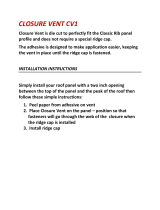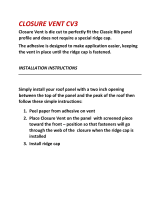Page is loading ...

Quick Tips for Installation
Installing ONDURA Sheets On A New Structure.
On new buildings, ONDURA sheets install
either over purlins or over solid decking covered by
roofing felt. Over decking, simply follow these same
instructions making sure that decking is secure be-
fore nailing down sheets. We strongly recommend
solid decking for buildings with interior ceilings. If
installing over purlins, space purlins 24” (60cm) for
greater than 15
o
slope and space purlins 18” (45cm)
for a slope between 10
o
-15
o
.
CAUTION: Avoid installation when the
material temperature is below 32
F (0°C).
Re-Roofing With ONDURA Sheets.
ONDURA works well as a new roof over an
old asphalt shingle roof. Over roofs with a uniform
surface, just install sheets using nails long enough to
penetrate 1" (2.54cm) into supports of the decking
beneath. Over corrugated metal or other irregular
roofs, first install nailer strips using lumber spaced
appropriately for the slope of the roof, then lay
ONDURA sheets per instructions. Be sure that nail-
ing strips are securely in place.
Drive Nails Correctly.
CAUTION: Use only genuine ONDURA
nails for installing sheets and tiles. Other types of
nails may not provide sufficient hold-down strength.
Drive ONDURA nails only through the top
of corrugations. Always drive nails perpendicular
into purlins-not at an angle-so the rubber washer is
snugly in contact with the sheet. See Fig. 1. Do not
overdrive or underdrive nails. Slight hand pressure
on a nailed-down corrugation should not separate the
sheet from washer contact.
Fig. 1
Yes No No
Installing The First Sheet.
1. From the corner where
the eave and rake meet,
measure along the eave 48
inches (122cm) and mark.
2. From the corner of the
rake and the ridge, measure
along the ridge 48 inches
(122cm) and mark.
3. Snap a chalk line con-
necting these marks for sheet
alignment.
Fig. 3
4. Starting at the eave/rake corner, fasten the rake
corrugation of the first sheet at each purlin along the
rake (see Fig. 3 for Nailing Pattern).
5. Now align the opposite edge of the sheet with the
chalk line. Nail in place along the second corruga-
tion from the chalk line to allow for the side lap of
the next sheet. Be sure to install closure strip before
nailing eave.
Finishing The First Row Of Sheets.
You can now install the remainder of the
first row.
1. From the first chalk line, mark off successive 44
inch (112 cm) spaces along the eave. Do the same at
the ridge. (This 44 inch /122cm distance allows for a
1 corrugation side lap.)
2. Snap chalk lines between the eave and ridge
marks for sheet alignment.
3. Noting the nailing pattern in Figure 3, install the
rest of the eave row.
Edges with X’s are not nailed
down until lapped by adjoining
sheets.
Walking On ONDURA Sheets.
When walking on nailed-down ONDURA
sheets, walk on top of purlins only placing feet
across corrugations. Also wear soft-soled shoes.
ONDURA is more pliable in hot weather
and less pliable in cold weather. Always use care
when walking on ONDURA or any other roof.
Pulling Nails From Sheets.
To pull a nail from sheet, use a claw ham-
mer and a 1-1/2" (3,81cm) wood dowel or pipe. Put
the dowel or pipe in the valley of the corrugation
next to the crown with the nail to be pulled. Then
use the dowel or pipe as a leverage point for pulling
the nail. See Fig. 2.
Fig. 2

Quick Tips for Installation
Installing The Second Row Of Sheets.
The second row can be installed so that all
side-laps meet lower sheets in the middle, or so that
all side-laps line up from row to row up the slope of
the roof to offset the side lap of one row from the
other.
To stagger the side laps from row to row,
begin the second row with a sheet cut in half along
its length (see Fig. 4). Be certain to cut the sheet in
its valley. Since the edge of this first sheet will not
line up with the chalk line of the first row, make a
new line half a sheet’s distance from the rake. Now
install the remainder of the second row using full
sheets and new chalk lines every 44 inches (112cm)
for alignment. Lap the lower end of the second row
7 inches (17,8 cm) over the upper end of the first
row. Be certain that the center of each lap is over the
center of the purlin beneath.
To have all side laps of all rows line up,
simply begin the second row with a full sheet and
install this and all subsequent rows in the same man-
ner as in the first row (see Fig. 5).
Fig. 4
Fig. 5
Installing Ridge Caps.
Install all sheets on both sides of roof before
laying the ridge. At the ridge the upper end of the
sheets should be no more than 2 inches (5,08cm)
apart to properly support the ridge cap.
Place the first ridge cap at the end of the
ridge away from the prevailing wind, allowing it to
project out 3 to 6 inches (7,62 to15,24cm) from the
ridge end. Insert closure strip then drive ONDURA
nails through ridge piece, closure strip and every
Crown (Not Valley) of the underlying sheets. Now
cut in 3 to 6” inches (7,62 to 15,24cm) along the
crown of the portion of ridge cap projecting out from
the end. Fold down the resulting flaps for a weather
guard. Position the subsequent ridge caps with a 7
inch (17,8cm) end lap.
Information for Quick Estimating.
ONDURA Sheets are 79” x 48” (200cm x 122cm)
ONDURA Ridge Caps are 79” x 19” (200cm x
48cm)
Sheets needed to cover 100 square feet = 4.5
End lap each ridge cap by 7” (17,8cm)
Use 24 nails per sheet
Use 38 nails per ridge cap
Closure strips needed:
Total the length in inches of the eaves plus twice the
length of the hips, ridges, and valleys. Divide the
total inches by the 44 (the length of the closure
strips) to get the number of closures needed.
For more installation information consult the
complete Ondura Installation Guide or visit our web
page at www.ondura.com.
Onduline North America
4900 Ondura Drive
Fredericksburg, VA 22407 – USA
Tel: 540-898-7000, Fax: 540-898-4991
www.ondura.com
Fig. 6 Ridge Cap at Gable End
Fold down flaps on end of Ridge Cap.
/













